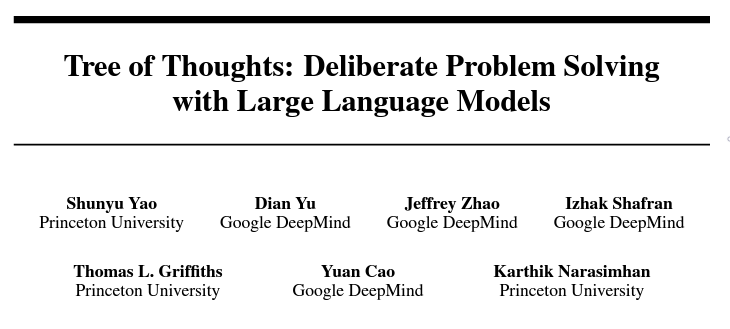
Imagine boosting the problem-solving power of an artificial intelligence by an astounding 900%!
That’s exactly what researchers at Princeton University and Google DeepMind have accomplished in a groundbreaking study with a technique they call the “Tree of Thoughts”.
We’ve all heard the old adage that humans only use 10% of their brain. Whether or not that’s true, it appears this underutilization may also apply to our Artificially Intelligent models.
In a world where Artificial Intelligence is becoming increasingly embedded in our everyday lives, enhancing their capabilities is vital.
The team at Princeton and Google DeepMind have tackled this issue, making a giant leap in GPT-4’s problem-solving capacity, from a mere 4% to a staggering 74%!
Unveiling the Tree of Thoughts (ToT)
The key to this leap lies in a new method of prompting called the “Tree of Thoughts” or ToT. Traditionally, we’ve used Input-Out put (I-O) prompting when interacting with Artificially Intelligent models like GPT-4.
You ask a question, and it provides an answer. Simple, right? But the researchers found that using a more involved prompting approach, called the “Chain of Thought” (CoT), yields better results.
The CoT approach is like thinking through several topics before selecting the best one to discuss. It’s like planning a conversation, considering various outcomes, and then deciding on the most engaging topic. But the researchers didn’t stop there. They combined this method with “self-consistency,” which involves generating multiple results for each query and choosing the most consistent one. This blend of CoT and self-consistency led to even better results.
However, the real game-changer came with the introduction of the Tree of Thoughts method. The ToT approach allows GPT-4 to explore multiple reasoning paths over thoughts, enhancing its problem-solving abilities for complex tasks.
Tree of Thought in Action
To truly appreciate the power of ToT, let’s look at its application in a couple of practical scenarios. First, the team tested it on the Game of 24, a mathematical reasoning challenge. The ToT approach outperformed all other methods, solving 74% of tasks, a far cry from the mere 4% achieved with CoT.
Next, the researchers tested ToT on a creative writing task. Given four random sentences, the AI had to create a coherent passage using these sentences as the final lines of four paragraphs. The results were impressive. The ToT approach skillfully wove a narrative around the disparate sentences, demonstrating an ability to think, plan, and execute at a level far beyond the standard I-O approach.
Even when tackling 5×5 mini crosswords, a notoriously challenging task, the ToT approach was superior, achieving a word-level success rate of 60%.
The Future of AI with ToT
While this breakthrough is impressive, it’s important to remember that more powerful AI also comes with its share of challenges. For instance, the ToT approach requires more resources, which could potentially make Artificial Intelligence services more costly.
However, it’s not all doom and gloom. The modular flexibility of ToT allows users to customize performance trade-offs, and ongoing open-source efforts promise to reduce such costs in the near future. Furthermore, the ToT approach increases the interpretability of Artificially Intelligent decisions, making it easier for humans to understand and align with AI reasoning.
In conclusion, the Tree of Thoughts represents a monumental leap forward in our ability to unlock the full potential of AI models like GPT-4. As we continue to explore this fascinating new frontier, the possibilities for AI to enhance and enrich our lives are truly limitless.
The Implications of the Tree of Thoughts
An exciting aspect of the Tree of Thoughts method is its potential for future applications.
The research paper comes with a caution, acknowledging that while ToT empowers language models to make more intelligent decisions and solve complex problems, it could also potentially facilitate harmful uses of Artificial Intelligence, particularly in interactions with external environments or humans.
However, the paper also reassures us that the ToT approach improves the interpretability of Artificially Intelligent decisions, making it a valuable tool for improving human-AI alignment.
A New Dawn in AI Reasoning
The development of the Tree of Thoughts marks a new chapter in the evolution of Artificial Intelligence. By taking inspiration from human problem-solving techniques, researchers have found a way to significantly enhance the reasoning abilities of AI. ToT represents a significant departure from traditional AI methods, and the potential applications for this technology are broad and exciting.
Whether it’s enhancing the way we interact with Artificially Intelligent assistants, improving the efficiency of automated systems, or making breakthroughs in AI research, the Tree of Thoughts approach promises to revolutionize the way we think about and utilize artificial intelligence. It’s a testament to the incredible advances in Artificial Intelligence and a hint of the amazing developments still to come.
Conclusion
In the grand scheme of things, the Tree of Thoughts is more than just a research paper or a new prompting method. It’s a testament to human innovation and our relentless quest to unlock the full potential of technology. This study illuminates a path to a future where Artificial Intelligence can more effectively serve us, addressing complex problems and enhancing productivity in countless ways.
As we refine and develop these techniques, we are one step closer to an era where AI truly understands and assists us in ways we could only imagine. The Tree of Thoughts isn’t just a leap forward for Artificial Intelligence it’s a leap forward for us all.
And as we stand on the edge of this exciting new frontier, one thing is certain: the journey of AI, much like the tree of thoughts itself, is only just beginning to branch out.
Note: The views and opinions expressed by the author, or any people mentioned in this article, are for informational purposes only, and they do not constitute financial, investment, or other advice.
Relevant Articles:
AI News: Unveiling the Fascinating World of Artificial Intelligence
Snapchat Joins AI: Discover the All-New ‘My AI’ Chatbot
GPT-4 Seems Smarter than we think: What is SmartGPT?